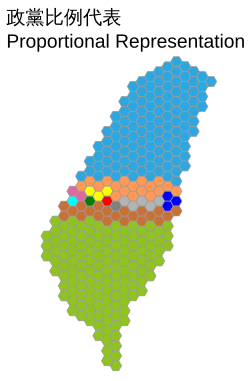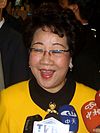Taiwan National Assembly election, 2005
|
|
|||||||||||||||||||||||||||||||||||||||||||||||
|---|---|---|---|---|---|---|---|---|---|---|---|---|---|---|---|---|---|---|---|---|---|---|---|---|---|---|---|---|---|---|---|---|---|---|---|---|---|---|---|---|---|---|---|---|---|---|---|
|
|||||||||||||||||||||||||||||||||||||||||||||||
|
All 300 seats to the National Assembly |
|||||||||||||||||||||||||||||||||||||||||||||||
|
|||||||||||||||||||||||||||||||||||||||||||||||

Election results
|
|||||||||||||||||||||||||||||||||||||||||||||||
An election for the National Assembly took place in Taiwan on Saturday 14 May 2005, from 07:30 to 16:00 local time. It elected an ad hoc National Assembly whose only function was to serve as a constitutional convention in order to approve or reject amendments to the Constitution of the Republic of China already proposed by the Legislative Yuan. The results indicated that the amendments would be approved, as the parties supporting them won an overwhelming majority, and indeed the amendments were passed on June 7, 2005. The election was carried out using purely the party-list proportional representation system. The official campaign period was 07:00 to 22:00 each day from 4 May 2005 to 13 May 2005. Official election broadcasts by the ad hoc coalitions (officially termed 'unions') and (established) parties were provided by the Public Television Service Taiwan on 7 May 2005; several unofficial debates were also arranged. Notably, this election saw the temporary breakdown of the traditional two-coalition system in Taiwanese politics: instead of dividing into the Pan-Green Coalition and Pan-Blue Coalition over the political status of Taiwan, the parties divided themselves into larger and smaller parties, with the larger Democratic Progressive Party and Kuomintang in support of the amendments and the smaller People First Party and Taiwan Solidarity Union against them.
...
Wikipedia



